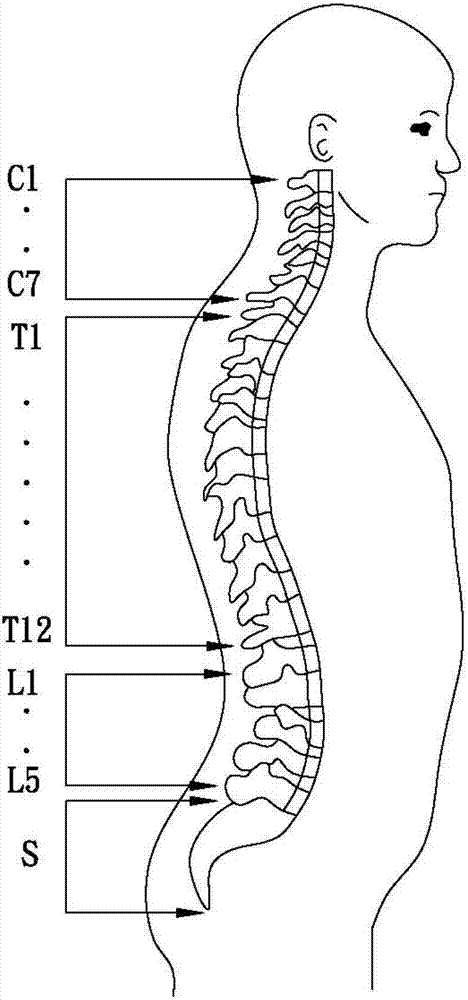[0004] (1) The radian of the
medial side of the central longitudinal section of the hard plate of the traditional back frame 10, 20 along the vertical direction, and the curve of the kyphotic curvature of the
thoracic spine of the
human body and the
lordosis of the
lumbar spine of the human body The S-shaped curve formed by the lordotic curvature of the
lumbar spine, see image 3 As shown, they do not match, completely unable to correctly and stably support the user's thoracic vertebrae (thoracic vertebrae) T1-T12,
lumbar vertebrae (
lumbar vertebrae) L1-L5 and their surrounding musculature. The traditional back frames 10, 20 In order to make up for this shortcoming, the manufacturer covers the foam pad on the hard board, hoping that the shape and elasticity of the foam pad will allow the user to feel the back of the chest and
waist. However, in fact, the support felt by the user is the virtual support of the foam pad, rather than the real, correct and stable support. Therefore, after being used for a long time, the traditional back frame 10,20 , often due to the twisting and deformation of the foam pad, the traditional back frame 10, 20 will lose all the supporting functions, and even cause the user's thoracic vertebrae T1-T12, lumbar vertebrae L1-L5 and their surrounding muscles As a result, the tissue shifts to an incorrect position, and the fine-tuning and correction of
cervical spine C1-C7,
thoracic spine T1-T12, and lumbar spine L1-L5 cannot be achieved at all;
[0005] (2) The inner surfaces of the traditional back frames 10 and 20 are often too soft due to the elasticity of the foam pad itself; The material properties of the board make it
extremely hard; neither of them can correctly and stably support the user's thoracic vertebrae T1~T12, lumbar vertebrae L1~L5 and the surrounding musculature. On the contrary, the user's thoracic vertebrae T1~T12, lumbar L1-L5 and the surrounding musculature are prone to fatigue due to the deviation of the support position, and then due to wrong adjustment of the
sitting posture, the thoracic vertebrae T1-T12, lumbar vertebrae L1-L5 and the surrounding musculature are gradually shifted to incorrect s position;
[0006] (3) The volume of the traditional back frames 10 and 20 is relatively large. When the user places the traditional back frames 10 and 20 on the back of a chair and sits on the chair, the traditional back frames often 10 and 20 take up too much seat space, which causes the user's
buttocks to be unable to be positioned in the correct position, refer to image 3 As shown, the sacral vertebrae S of the
buttocks, together with the upper lumbar vertebrae L1-L5 and thoracic vertebrae T1-T12, cannot maintain a normal S-shaped curve, which in turn causes the surrounding muscles to The tissue is tight and difficult to relax, especially when the user places the traditional back frame 10, 20 on the backrest of the car driver's seat, often because the traditional back frame 10, 20 occupies too much of the driver's seat As a result, the user's
buttocks cannot get enough support, which makes it difficult for the feet to apply force correctly when stepping on the accelerator or
brake, resulting in danger;
[0007] (4) The traditional back frame 10, 20 is only a seat back
cushion at best, although it can provide the user with a relatively comfortable riding environment at the beginning of use, once the comfort is no longer there is no function, and Becoming a discarded object not only causes a waste of resources, but also violates the
environmental protection demands of energy saving and carbon saving;
[0008] (5) The traditional back frame 10, 20 does not have a mechanism for performing
acupressure massage on the user's back at all, and does not have the ability to install electrodes (electrodes) thereon to pass through an
electrotherapy device (
electrotherapy device). ) and the electrodes, respectively, the ability to apply
electrotherapy to
acupuncture points on the user's back; and
[0009] (6) Review figure 1 , figure 2 and image 3 As shown, the traditional back frames 10, 20 do not have the ability to support the human
cervical spine (cervical spine) C1-C7 at all, however, the
distortion and deformation of the human cervical spine C1-C7 often lead to human thoracic spine T1-T12, lumbar spine L1-L5 and the surrounding musculature gradually deviate from the correct position
 Login to View More
Login to View More  Login to View More
Login to View More 


